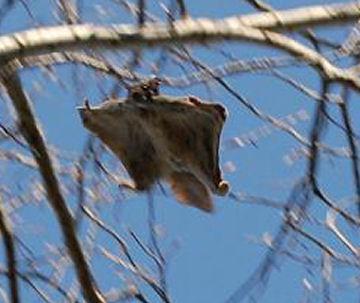The National Park Service has a cumbersome conundrum on its hands at the Blue Ridge Parkway, where the agency is grappling with how to preserve scenic vistas along the 469-mile-long road while not making further inroads on habitat critical for the Carolina Northern Flying Squirrel.
On one hand, the Park Service needs to maintain the painstakingly selected vistas from 264 overlooks. On the other, it's also charged with working not just to preserve species listed under the Endangered Species Act, of which the Carolina Northern Flying Squirrel is one, but to also "prevent detrimental effects on these species."
And then there are at least two wild cards in this equation: 1) The squirrel's habitat probably is shrinking, "due to natural warming conditions since the last ice age," and; 2) The Parkway doesn't currently have the staff, and probably doesn't have the funds, to implement its preferred alternative.
This dilemma arose because scenic overlooks were considered an integral feature of the Parkway from the very beginning of its planning, as the Parkway notes in an Environmental Assessment concerning overgrown vistas and flying squirrels that was released in March:
The sequence of views through individual sections of the Parkway were carefully planned. Many of these planned vistas had specific points of interest such as a scenic mountain peak, a rock outcrop, waterfall, lake, stream, or farmstead that were showcased as focal points. Designers envisioned the planned scenic vistas to remain open as a window to the scenic beauty as is evident on the original design Parkway Land Use Maps (PLUMs) drawings that show where they were located and how large an area they included. The need to actively manage vistas through vegetation removal is essential to keeping this recreation opportunity available to future generations.
While the Parkway in recent years has relied on contractors to prune the overlooks, three years ago the Park Service decided to "stop clearing vistas within potential (flying squirrel) habitat until an evaluation of impact to (flying squirrels) was made."
It turns out that Carolina Northern Flying Squirrels, which were listed as an endangered species in 1985, prefer forests comprised largely of spruce and fir trees. And the U.S. Fish and Wildlife Service has identified several areas within the Parkway as "geographic recovery areas" for the flying squirrel. In fact, of the Parkway's 264 overlooks, 138 are considered to fall within potential habitat for the squirrels. These areas can be found along:
* Milepost 350.6-366.9 (the Mt. Mitchell/Craggy area)
* Milepost 407.5-408.4 (the Mt. Pisgah area)
* Milepost 417.9-433.3 (the Graveyard Fields/Richland Balsam area)
* Milepost 445.8-458.2 (the Waterrock Knob area).
With hopes of maintaining the Parkway's vistas while not nibbling away at flying squirrel habitat, the Parkway's preferred alternative for pruning calls for "removing spruce trees only as necessary to open up or to maintain the view, while keeping enough trees so squirrels can still glide from one tree to another without having to run across open ground. Additionally each site will be evaluated to see if the boundaries of the vista can be modified to reduce the total area cut without impacting the view. Implementation of mitigation objectives would both maintain the vista for visitor enjoyment and enhance potential CNFS habitat. Biologists and Landscape Architects in the Resource Planning & Professional Services Division would be responsible for the vista management program within potential CNFS habitat and would determine which trees can be cut at each individual vista and any other mitigation measures that are needed."
While perhaps a noble solution, this alternative has its flaws. For one, the Parkway doesn't currently have a landscape architect on its staff. Then, too, there's the labor involved with the necessary on-site work for deciding which branches are trimmed and which are not.
Here's the take Dr. Houck Medford, executive director of the Blue Ridge Parkway Foundation, has on the preferred alternative:
The operating budget for the Blue Ridge Parkway has only increased one-half of one per cent since 1980. Funding for the National Park Service or the Blue Ridge Parkway is not expected to be increased significantly in the years ahead despite current funding initiatives. A quarter of the permanent work force of the Blue Ridge Parkway has been lost since 2002 and those vacancies still remain unfilled – including the positions of a landscape architect, community planner, and public information officer. Another twenty-five per cent of the work force is eligible for retirement in the next four years. If the Park Service commits to its preferred alternative, it will more than likely find itself down the road unable to service the highly labor intensive management alternative, give up because it can’t keep up, and then completely abandon any vista clearing management program in the CNFS critical habitat areas. The originally conceived and designed historical views of the Blue Ridge Parkway would (I didn’t say could) be lost forever.
Public comment on the EA is being taken through May 20. You can read the document, and its three alternatives, and make your comments at this site.


 Support Essential Coverage of Essential Places
Support Essential Coverage of Essential Places







Comments
Additional comments have been posted on the Blue Ridge Parkway Foundation's Executive Director Web Log
http://www.blueridgeparkwayblog.com/foundation-executive-director/genera...